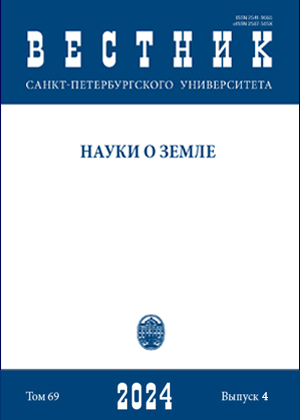Spatial organization and functional structure of the Ukok Plateau cultural landscapes
DOI:
https://doi.org/10.21638/spbu07.2024.404Abstract
The article is devoted to the analysis of the functional structure and identification of patterns of spatial and temporal organization of cultural landscapes of the Ukok plateau, which is located in the Southeastern Altai on the border of Russia, China, Mongolia and Kazakhstan. This territory is interesting because, despite the inaccessibility and absence of settlements with a permanent population, it has a long history of economic development, as well as important sacred significance for the indigenous population of Altai. Based on the analysis of literary sources, own field observations, as well as the results of interviews, the main types of cultural landscapes of the plateau: cattle-breeding, border, industrial, environmental-conservation, tourist-recreational, sacred. Each of them has its own internal structure with a characteristic set of elements and obvious spatial coherence. It was revealed that different types of cultural landscapes in their territorial organization are determined by different geographical and social factors – positional (border cultural landscapes), natural landscape (cattle breeding and environmental-conservation), natural resource (industrial), transport and landscape aesthetic (tourist-recreational), historical and religious-mythological (sacred). Modern trends in the dynamics of Ukok's cultural landscapes caused by climatic, socio-economic and institutional changes are also revealed. In particular, the geography of pasture lands and the mode of use of pastures have changed as a result of changes in snowfall, as well as the formalization of the rights of economic use of the territory. The development of tourism determines the diversification of the economic activities of local livestock breeders and the emergence of new elements in the cultural landscapes of Ukok. The borderline and environmental-conservation status of the plateau led to the actual elimination of previously existing hunting cultural landscapes, and the problem of transport accessibility and harsh working conditions became prerequisites for the collapse of the mining industry and the degradation of industrial cultural landscapes. The article contributes to the understanding of the processes of formation and development of cultural landscapes of underdeveloped peripheral territories with a predominance of traditional nature management. It is important to take this into account in the strategic planning of their development.
Keywords:
functional types of cultural landscapes, Ukok plateaus, Southeastern Altai, geocultural space, transformation, life cycle of social systems
Downloads
References
Банников, К. Л. (2021). Плато Укок. Перекресток эпох и культур. В: Сибирь как поле межкультурных взаимодействий: литература, антропология, историография, этнология. М.: Ин-т мир. лит. им. А. М. Горького РАН, 103–132.
Деревянко, А. П. и Молодин, В. И., ред. (2000). Феномен алтайских мумий. Новосибирск: Ин-т археол. и этногр. СО РАН.
Дирин, Д. А. (2015). Основные подходы к исследованию культурных ландшафтов в российской культурной географии. Социально-экономическая география. Вестник Ассоциации российских географов-обществоведов, 4, 24–37.
Дирин, Д. А. (2018). Концепт «геокультурное пространство» в общественной географии. Социально-экономическая география. Вестник Ассоциации российских географов-обществоведов, 7, 146–160.
Куминова, А. В. (1960). Растительный покров Алтая. Новосибирск: Изд-во АН СССР.
Ливинская, О. А. (2013). Классификация и районирование культурных ландшафтов в рамках информационно-аксиологического подхода. Вестник Псковского государственного университета. Сер.: Естественные и физико-математические науки, 2, 125–131.
Лысенкова, З. В. (1997). Ландшафтная структура плоскогорья Укок. География и природопользование Сибири, 2, 70–79.
Манаков, А. Г. (2002). Геокультурное пространство северо-запада Русской равнины: динамика, структура, иерархия. Псков: Центр «Возрождение» при содействии ОЦНТ.
Молодин, В. И., Полосьмак, Н. В., Новиков, А. В., Богданов, Е. С., Слюсаренко, И. Ю., Черемисин, Д. В. (2004). Археологические памятники плоскогорья Укок (Горный Алтай). Новосибирск: Ин-т археол. и этногр. СО РАН.
Нарожный, Ю. К., Галахов, В. П., Редькин, А. Г., Суразаков, А. Б. (1999). Оледенение горного узла Табын-Богдо-Ола и его режим. Известия Русского географического общества, 131 (3), 57–60.
Окладникова, Е. А. (2014). Сакральный ландшафт: теория и эмпирические исследования. М.; Берлин: Директ-Медиа.
Октябрьская, И. В. (1994). Этнографические исследования на плоскогорье Укок. В: Древние культуры Бертекской долины. Новосибирск: Наука, 199–207.
Полосьмак, Н. В. (1994). «Стерегущие золото грифы» (Ак-Алахинские курганы). Новосибирск: Ин-т археол. и этногр. СО РАН.
Полосьмак, Н. В. (2001). Всадники Укока. Новосибирск: ИНФОЛИО.
Радлов, В. В. (1989). Из Сибири. Страницы дневника. М.: Наука. Гл. ред. вост. лит.
Ревякин, В. С., Галахов, В. П., Голещихин, В. П. (1979). Горноледниковые бассейны Алтая. Томск: Изд-во Том. ун-та.
Романчук, С. П. (2002). Сакральные ландшафты. Гуманитарный экологический журнал, 4 (1), 112–114.
Рудой, А. Н., Лысенкова, З. В., Рудский, В. В., Шишин, М. Ю. (2000). Укок (прошлое, настоящее, будущее). Барнаул: АлтГУ.
Рудой, А. Н. и Кирьянова, М. Р. (1996). Эрозионные террасы и экзогенная геоморфология Северо-Восточного Сайлюгема, бассейн Чуйского котловины, Алтай. Геоморфология, 1, 87–96.
Рудский, В. В. (1996). Алтай. Эколого-географические основы природопользования. Барнаул: АлтГУ.
Самойлова, Г. С. (1982). Ландшафтная структура физико-географических регионов Горного Алтая. В: Вопросы географии (Ландшафтоведение: теория и практика). М.: Мысль, 154–164.
Сапожников, В. В. (1949). По русскому и монгольскому Алтаю. М.: Гос. изд-во геогр. лит.
Семенцов, Б. Г. (2005). Калгутинский вольфрамовый рудник (история геологического изучения и разработки Калгутинского месторождения). Природные ресурсы Горного Алтая, 3, 3–26.
Суразакова, С. П. (2010). Проблемы устойчивого землепользования горных территорий. Устойчивое развитие горных территорий, 4 (6), 49–53.
Тронов, Б. и Тронов, М. (1924). Исследования в Южном Алтае. Известия Томского университета, 74, 216–240.
Hägerstrand, T. (1967). Innovation Diffusion as a Spatial Process. Chicago; London: University of Chicago Press.
Lefebvre, H. (1991). The production of Space. Transl. by D. N. Smith. Oxford: Basil Blackwell.
Downloads
Additional Files
Published
How to Cite
Issue
Section
License
Articles of "Vestnik of Saint Petersburg University. Earth Sciences" are open access distributed under the terms of the License Agreement with Saint Petersburg State University, which permits to the authors unrestricted distribution and self-archiving free of charge.






